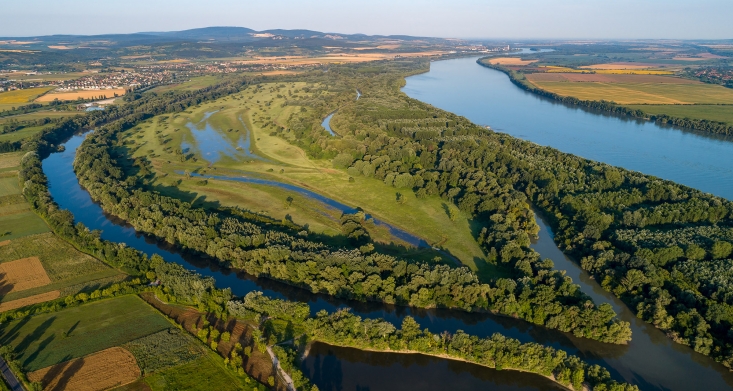The priority nature protection of the 299.91-hectare area serves to preserve and maintain the remnants of the former natural wetlands and habitats near water along the Danube.
Affected settlements: Esztergom, Süttő, Tát
Extent: 299.91 hectares
Legislation declaring it protected: 7/2020 on the establishment of the nature reserve of the Danube Islands of Táti and Süttő. (III. 25.) no. Decree AM.
The declaration as protected and the announcement of the nature conservation management plan - among other things - help to achieve the following landscape and nature conservation objectives:
- preserving the natural pattern of marshes and softwood groves, unique in their species richness, which were once common to the banks of the Danube,
- protected, highly protected plant species, e.g. preservation of the habitat and populations of the speckled aster, the Siberian lady's petal, the hornwort and the marsh sedge,
- protected, highly protected animal species, e.g. ensuring the living conditions of the black stork, golden eagle, harris and the European beaver,
- presentation of the area for nature conservation purposes.
Danube shelters
The XIX The Danube islands that remained after major river regulation in the 19th century represent outstanding value by breaking the monotony of the river.
In their natural state, the typical populations of floodplain forests and gallery forests along the river, coastal scrub and softwood groves located inland were present on the islands. However, most of the woodlands (e.g. on Nyáros Island) began to be harvested from the 1950s, which gained new impetus in the 1970s as a result of the contract for the construction of the Bős-Nagymaros barrage system. Today, only a small part of the former white summer groves remains.
A significant part of the Körtvélyesi island is occupied by a floodplain meadow that serves as a habitat for special natural values. Thanks to the differences in level of a few meters, there are many diverse habitats, from areas with long periods of standing water to dry grasslands on higher terrains, forming a complex, dynamic system.
The fauna is also diverse in the diverse habitats, e.g. the dragonfly fauna is an outstanding value of the area: the surveys proved the presence of 17 species. Many bird species choose the islands as breeding, migrating or resting places: during decades of research, the presence of 241 species has so far been detected in the area, of which nearly 100 species have bred or are still breeding today.
The islands also enable the formation of "quiet waters" free of waves, where the fish fry can develop undisturbed in the ever-increasing ship traffic.
Dangers
Traditional management - such as grazing and mowing - helped to preserve the grasslands and provided a habitat for colorful protected plants such as cornflower and meadowsweet. With the cessation of grazing and mowing, nature began to take back the area, but the disrupted balance no longer favored the return of previously native plants and animals, but an opportunity for new, aggressively expanding species.
Flow regulation did not avoid this tributary system either. Transverse paving and closures were built to improve navigation conditions, and a side branch was filled in, which as a result has now disappeared. The partially closed tributaries began to silt up. And the increasingly extreme water cycle brings rarer, but all the more intense, short floods. This situation is also quite unfavorable for the fish species that reproduce in the Danube floodplain, since spawning can take place, but the fry or eggs die due to the rapid receding of the flood.
Active nature conservation
Recognizing these problems, the Danube-Ipoly National Park Administration implemented a four-part habitat reconstruction investment in recent years (2016-2020). By dredging the river bed, more water gets between the islands, with the help of new locks, the flow of the tidal wave can be controlled, and in the small artificial lake, fish and amphibians can breed undisturbed. Extermination of the non-native, aggressively spreading green maple and American ash has begun, and native poplars and pedunculated oaks are being planted in their place.
The nature conservation protection of the Danube Islands of Tát and Süttő, effective from April 2020, also promotes the long-term maintenance of the results of this project.
